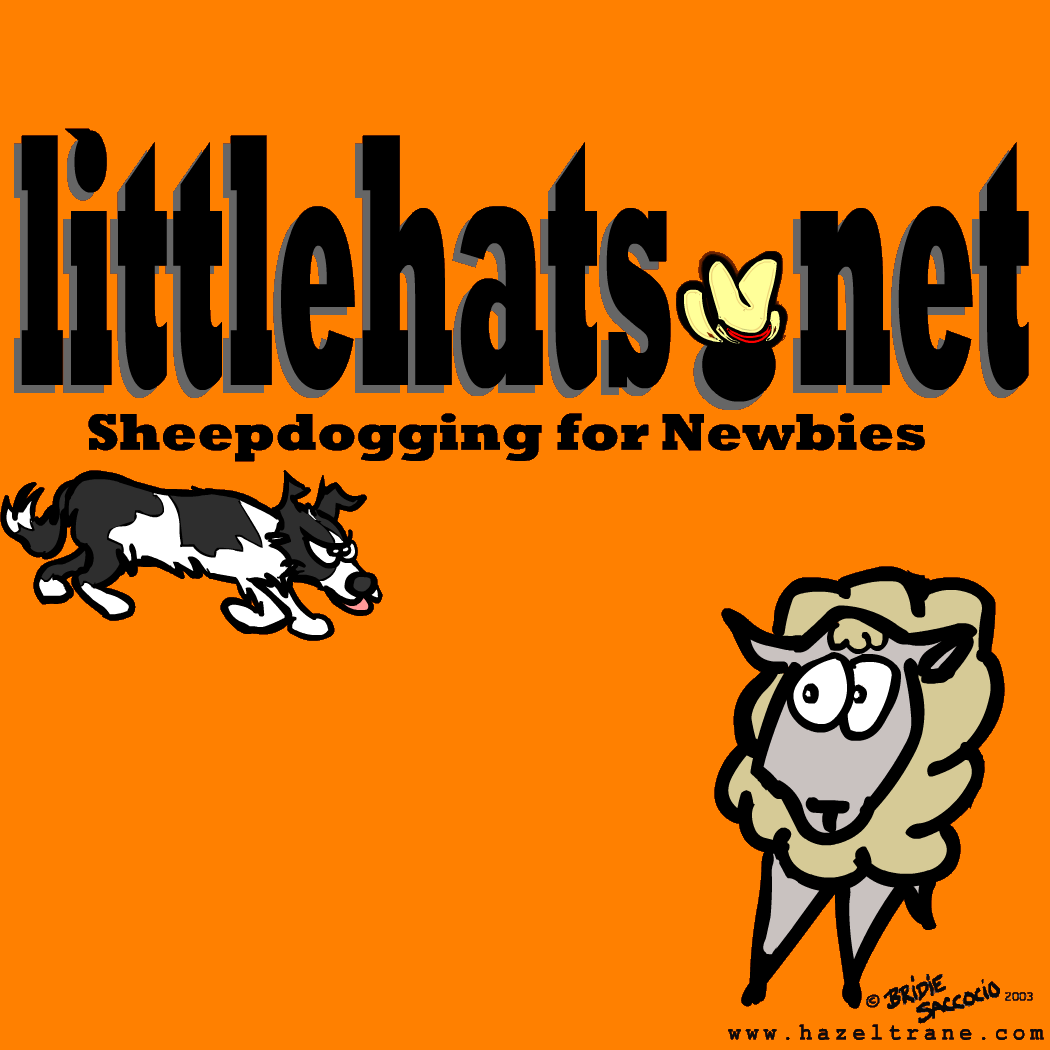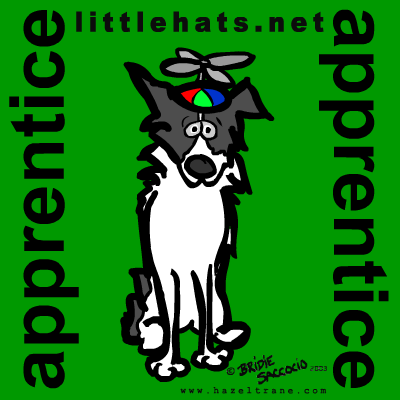


Teaching a Shed
by Carol Campion
Search This Site
The first thing to think about in shedding is that at first the dog has NO CLUE what you want him to do. So you need to make it as clear as can be. Once the pattern of behavior is set up, (opening in sheep appears-dog comes in and take control of some of the sheep) then the dog gets some idea of what is expected and it makes further progress easier.
I find its easiest to teach with a big group of sheep. Put all your sheep together and get them along a fence with a dog or grain. Once they are along the fence and settled-walk into them and watch what happens. Where you come into them created a split. You don't need a dog for this and should try it without a dog. The trick is to place yourself and the dog across from each other in such a way as to create that split. In the beginning, you want to call the dog in once you have already helped create a good opening. Remember, he doesn't know what you want. So you need to work the sheep to help them split. Later in training the dog will create the split.
Take all the sheep and find a place where they will naturally string out (as though they were being crossdriven in a single line). You know your property well enough to know where you could put the whole flock and they will start to drift to another point. What I do is have the dog fetch me the sheep. Then I let the sheep settle and give them the freedom to feel they can "drift off" in a particular direction by lying the dog down off balance. Then I start working my dog "off balance". (It's very hard for an inexperienced dog to split sheep if it is balancing them to you and its hard to split sheep that are facing you. The dog wants to keep balancing and don't like to let sheep go and the sheep can feel this and bunch up in front of you. Facing sheep will fold past you as you try to shed them. )
Say the pressure is to the left--a barn say. I have to dog bring the sheep to me and have the barn to my left. Then I lay the dog down a little off balance and maybe flank it come bye and lay it down to let the sheep think they can drift to my left and to get away to the barn. Don't let the dog balance them to you. Don't gather them and stop them. You need this drifting-sideways movement to aid in learning to set this up. Start moving "come-bye" yourself to walk along parallel to the sheep but not so far as to stop them. At the same time, once the sheep start moving toward the pressure, flank the dog "away" but not so far as to stop the sheep--away only around some of the sheep. Basically you will be doing what you never wanted to do before--stop the dog short and not let it cover the sheep. If you practice this part and can flank the dog to keep it parallel to you and have both of you moving along the group of drifting sheep, you will notice that as you and the dog get towards the front of the group, some sheep from the back of the line will hesitate. You and your dog are kind of "pinching" them off by being in front of them. These are the ones you can shed off. You are creating a gap here and it becomes clear to the dog. By your placing of yourselves, you are making a gate that you can shut at any point by you and the dog walking in toward each other. It will split the sheep off at the back of the line just as you did when you walked into them along the fence without the dog.
Once you can ask for flanks that are stopped so that sheep are hesitating at the back of the group, step into the flock and call your dog--who should be somewhat across from you at the end of these flanks, to you. This should make the back sheep turn and you can wear or drive them away.
Another helpful thing is a body language message that tells the dog what is happening. As you maneuver the sheep for a set up, always try to face the sheep you are wanting to hold back. Keep in mind that you may need to be flexible in your set up and change the direction you face if the sheep shift directions. Try to decide on a phrase and use it consistently because once your dog "gets it," you can say the phrase when you are preparing to shed so they know the coming job. You also need a phrase to actually call the dog in. Some people also have an additional phrase for the work once the dog comes through and needs to hold the shed sheep. So as you go to the shedding ring (or approach the shedding task at the farm), you might say "Watch them" or something of that nature. This will cue the dog to what is going to happen. On an older experienced dog, you can see their entire demeanor change once they hear that. Then you might say "In here--this" as you face the ones to be shed and call the dog in. Once through, you might say "Hold them" or something to that affect to till the dog to keep them away. In time it will become second nature to hold sheep back and take some sheep away.
I find its easiest to teach with a big group of sheep. Put all your sheep together and get them along a fence with a dog or grain. Once they are along the fence and settled-walk into them and watch what happens. Where you come into them created a split. You don't need a dog for this and should try it without a dog. The trick is to place yourself and the dog across from each other in such a way as to create that split. In the beginning, you want to call the dog in once you have already helped create a good opening. Remember, he doesn't know what you want. So you need to work the sheep to help them split. Later in training the dog will create the split.
Take all the sheep and find a place where they will naturally string out (as though they were being crossdriven in a single line). You know your property well enough to know where you could put the whole flock and they will start to drift to another point. What I do is have the dog fetch me the sheep. Then I let the sheep settle and give them the freedom to feel they can "drift off" in a particular direction by lying the dog down off balance. Then I start working my dog "off balance". (It's very hard for an inexperienced dog to split sheep if it is balancing them to you and its hard to split sheep that are facing you. The dog wants to keep balancing and don't like to let sheep go and the sheep can feel this and bunch up in front of you. Facing sheep will fold past you as you try to shed them. )
Say the pressure is to the left--a barn say. I have to dog bring the sheep to me and have the barn to my left. Then I lay the dog down a little off balance and maybe flank it come bye and lay it down to let the sheep think they can drift to my left and to get away to the barn. Don't let the dog balance them to you. Don't gather them and stop them. You need this drifting-sideways movement to aid in learning to set this up. Start moving "come-bye" yourself to walk along parallel to the sheep but not so far as to stop them. At the same time, once the sheep start moving toward the pressure, flank the dog "away" but not so far as to stop the sheep--away only around some of the sheep. Basically you will be doing what you never wanted to do before--stop the dog short and not let it cover the sheep. If you practice this part and can flank the dog to keep it parallel to you and have both of you moving along the group of drifting sheep, you will notice that as you and the dog get towards the front of the group, some sheep from the back of the line will hesitate. You and your dog are kind of "pinching" them off by being in front of them. These are the ones you can shed off. You are creating a gap here and it becomes clear to the dog. By your placing of yourselves, you are making a gate that you can shut at any point by you and the dog walking in toward each other. It will split the sheep off at the back of the line just as you did when you walked into them along the fence without the dog.
Once you can ask for flanks that are stopped so that sheep are hesitating at the back of the group, step into the flock and call your dog--who should be somewhat across from you at the end of these flanks, to you. This should make the back sheep turn and you can wear or drive them away.
Another helpful thing is a body language message that tells the dog what is happening. As you maneuver the sheep for a set up, always try to face the sheep you are wanting to hold back. Keep in mind that you may need to be flexible in your set up and change the direction you face if the sheep shift directions. Try to decide on a phrase and use it consistently because once your dog "gets it," you can say the phrase when you are preparing to shed so they know the coming job. You also need a phrase to actually call the dog in. Some people also have an additional phrase for the work once the dog comes through and needs to hold the shed sheep. So as you go to the shedding ring (or approach the shedding task at the farm), you might say "Watch them" or something of that nature. This will cue the dog to what is going to happen. On an older experienced dog, you can see their entire demeanor change once they hear that. Then you might say "In here--this" as you face the ones to be shed and call the dog in. Once through, you might say "Hold them" or something to that affect to till the dog to keep them away. In time it will become second nature to hold sheep back and take some sheep away.